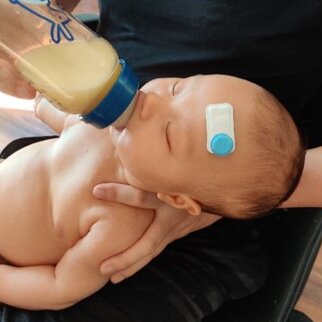Enhancing neonatal care in low- and middle-income countries with wireless wearable sensors
An estimated 3.6 million neonates die each year, with 99% of which in low and middle-income countries 1. Current neonatal care have relied on the same technologies for the past five decades, requiring myriads of hard-wired sensors tethered to a bulky and expensive base station, producing large amounts of medical data that are underutilized, and limiting the access of raw data that medical instrument companies consider as proprietary information.
Recent publications from the Rwei group in the Department of Chemical Engineering shows that scientists aim to advance the development of neonatal care with soft, flexible, and wireless wearable devices for the enhancement of neonatal care 2. Our focus is on two fronts: (1) the engineering of next-generation devices for advanced neonatal care, and (2) the development of novel data analytics with machine learning to achieve effective personalized care.
We have developed wireless wearable devices for the monitoring of neonatal vital signs, including heart rate, respiration rate, pulse oxygenation, temperature and cerebral oxygenation3, 4,. These novel devices enable the continuous monitoring of neonatal vital signs not only with a fraction of the original cost (from thousands of dollars to ~$25 per device), but also with convenient user interfaces accessible through cell phones. Together with the Erasmus Medical Center, we aim to further our development in wireless sensing to enhance neonatal care in low- and middle-income countries.
1. Belizán, J. M.; McClure, E. M.; Goudar, S. S.; Pasha, O.; Esamai, F.; Patel, A.; Chomba, E.; Garces, A.; Wright, L. L.; Koso-Thomas, M.; Moore, J.; Althabe, F.; Kodkany, B. S.; Sami, N.; Manasyan, A.; Derman, R. J.; Liechty, E. A.; Hibberd, P.; Carlo, W. A.; Hambidge, K. M.; Buekens, P.; Jobe, A. H.; Goldenberg, R. L., Neonatal death in low- to middle-income countries: a global network study. Am J Perinatol 2012, 29 (8), 649-656.
2. Xu, S.; Rwei, A. Y.; Vwalika, B.; Chisembele, M. P.; Stringer, J. S. A.; Ginsburg, A. S.; Rogers, J. A., Wireless skin sensors for physiological monitoring of infants in low-income and middle-income countries. The Lancet Digital Health 2021, 3 (4), e266-e273.
3. Chung, H. U.; Rwei, A. Y.; Hourlier-Fargette, A.; Xu, S.; Lee, K.; Dunne, E. C.; Xie, Z.; Liu, C.; Carlini, A.; Kim, D. H.; Ryu, D.; Kulikova, E.; Cao, J.; Odland, I. C.; Fields, K. B.; Hopkins, B.; Banks, A.; Ogle, C.; Grande, D.; Park, J. B.; Kim, J.; Irie, M.; Jang, H.; Lee, J.; Park, Y.; Kim, J.; Jo, H. H.; Hahm, H.; Avila, R.; Xu, Y.; Namkoong, M.; Kwak, J. W.; Suen, E.; Paulus, M. A.; Kim, R. J.; Parsons, B. V.; Human, K. A.; Kim, S. S.; Patel, M.; Reuther, W.; Kim, H. S.; Lee, S. H.; Leedle, J. D.; Yun, Y.; Rigali, S.; Son, T.; Jung, I.; Arafa, H.; Soundararajan, V. R.; Ollech, A.; Shukla, A.; Bradley, A.; Schau, M.; Rand, C. M.; Marsillio, L. E.; Harris, Z. L.; Huang, Y.; Hamvas, A.; Paller, A. S.; Weese-Mayer, D. E.; Lee, J. Y.; Rogers, J. A., Skin-interfaced biosensors for advanced wireless physiological monitoring in neonatal and pediatric intensive-care units. Nature Medicine 2020, 26 (3), 418-429.
4. Rwei, A. Y.; Lu, W.; Wu, C.; Human, K.; Suen, E.; Franklin, D.; Fabiani, M.; Gratton, G.; Xie, Z.; Deng, Y.; Kwak, S. S.; Li, L.; Gu, C.; Liu, A.; Rand, C. M.; Stewart, T. M.; Huang, Y.; Weese-Mayer, D. E.; Rogers, J. A., A wireless, skin-interfaced biosensor for cerebral hemodynamic monitoring in pediatric care. Proceedings of the National Academy of Sciences 2020, 117 (50), 31674.

